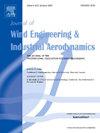A multiscale framework for the risk analysis of urban building envelope systems subject to windborne debris considering the directional effect of tropical cyclones
IF 4.9
2区 工程技术
Q1 ENGINEERING, CIVIL
Journal of Wind Engineering and Industrial Aerodynamics
Pub Date : 2025-07-03
DOI:10.1016/j.jweia.2025.106160
引用次数: 0
Abstract
Windborne debris poses a significant threat to the envelope systems of urban high-rise buildings during tropical cyclones (TCs). The time varying feature of TC surface wind makes it inadequate to ignore the wind direction effect in the analysis of the windborne debris risk to envelop systems. To address this issue, this paper proposes an integrated framework that spans the entire process from TC generation based on physical stochastic sources, to local urban wind environment simulations, and to detailed debris flight trajectory modeling and impact fragility analysis of envelope systems. This framework establishes a multiscale perspective for analyzing the uncertainty propagation associated with the windborne debris risk from regional meteorological scale to local urban scale and debris scale. First, the joint probability distribution of TC maximum wind speed and surface wind direction is derived based on TC wind hazard assessment technique. Next, the urban wind field is simulated by a computational fluid dynamics (CFD) model, and the debris flight trajectory in the local wind environment is simulated by a rigid-body dynamical model. The urban wind field model and debris flight trajectory model are then used to estimate the fragility of the envelope system given specific wind speeds and directions. Finally, the annual occurrence rate that the number of damaged glazing units exceeds certain thresholds is derived using the total probability theorem. A 100-m high-rise building located in Shanghai is used to illustrate the application of the proposed framework. A detailed analysis of the illustrative application is presented and the results show that ignoring wind direction effects may overestimate the risk of windborne debris to envelope systems.
考虑热带气旋方向性影响的城市建筑围护结构风载碎片风险分析的多尺度框架
在热带气旋(tc)期间,风载碎片对城市高层建筑的围护结构系统构成重大威胁。TC地面风的时变特征使得在分析风载碎屑对围护体系的风险时不能忽略风向效应。为了解决这一问题,本文提出了一个集成框架,该框架涵盖了从基于物理随机源的TC生成到局部城市风环境模拟,以及详细的碎片飞行轨迹建模和包络系统的冲击脆弱性分析的整个过程。该框架建立了一个从区域气象尺度到局部城市尺度和碎片尺度的多尺度视角来分析风沙风险的不确定性传播。首先,基于TC风害评价技术,推导了TC最大风速与地面风向的联合概率分布;其次,采用计算流体动力学(CFD)模型模拟城市风场,采用刚体动力学模型模拟局部风环境下碎片的飞行轨迹。然后利用城市风场模型和碎片飞行轨迹模型来估计给定特定风速和风向的包络系统的脆弱性。最后,利用全概率定理推导出玻璃单元损坏数量超过一定阈值的年发生率。以上海一座100米高的高层建筑为例,说明了该框架的应用。对实例应用进行了详细的分析,结果表明,忽略风向影响可能会高估风载碎片对包络系统的风险。
本文章由计算机程序翻译,如有差异,请以英文原文为准。
求助全文
约1分钟内获得全文
求助全文
来源期刊
CiteScore
8.90
自引率
22.90%
发文量
306
审稿时长
4.4 months
期刊介绍:
The objective of the journal is to provide a means for the publication and interchange of information, on an international basis, on all those aspects of wind engineering that are included in the activities of the International Association for Wind Engineering http://www.iawe.org/. These are: social and economic impact of wind effects; wind characteristics and structure, local wind environments, wind loads and structural response, diffusion, pollutant dispersion and matter transport, wind effects on building heat loss and ventilation, wind effects on transport systems, aerodynamic aspects of wind energy generation, and codification of wind effects.
Papers on these subjects describing full-scale measurements, wind-tunnel simulation studies, computational or theoretical methods are published, as well as papers dealing with the development of techniques and apparatus for wind engineering experiments.

 求助内容:
求助内容: 应助结果提醒方式:
应助结果提醒方式:


